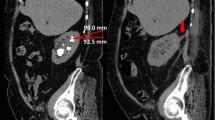Abstract
The objectives of this study are to assess the efficacy and safety of retrograde ureteroscopic holmium laser lithotripsy for intrarenal calculi greater than 2 cm in diameter. A total of 24 patients with a stone burden >2 cm were treated with retrograde ureteroscopic laser lithotripsy. Primary study endpoints were number of treatments until the patient was stone free and perioperative complications with a follow-up of at least 3 months after intervention. In 24 patients (11 women and 13 men, 20–78 years of age), a total of 40 intrarenal calculi were treated with retrograde endoscopic procedures. At the time of the initial procedure, calculi had an average total linear diameter of 29.75 ± 1.57 mm and an average stone volume of 739.52 ± 82.12 mm3. The mean number of procedures per patient was 1.7 ± 0.8 (range 1–3 procedures). The overall stone-free rate was 92%. After 1, 2 and 3 procedures 54, 79 and 92% of patients were stone free, respectively. There were no major complications. Minor postoperative complications included pyelonephritis in three cases (7.5%), of whom all responded immediately to parenteral antibiotics. In one patient the development of steinstrasse in the distal ureter required ureteroscopic fragment disruption and basketing. Ureteroscopy with holmium laser lithotripsy represents an efficient treatment option and allows the treatment of large intrarenal calculi of all compositions and throughout the whole collecting system even for patients with a stone burden of more than 2 cm size.
Similar content being viewed by others
References
Albala DM, Assimos DG, Clayman RV et al (2001) Lower pole I: a prospective randomized trial of extracorporeal shock wave lithotripsy and percutaneous nephrostolithotomy for lower pole nephrolithiasis—initial results. J Urol 166:2072–2080
Desai M, Jain P, Ganpule A, et al (2009) Developments in technique and technology: the effect on the results of percutaneous nephrolithotomy for staghorn calculi. BJU Int
Preminger GM, Assimos DG, Lingeman JE et al (2005) Chapter 1: AUA guideline on management of staghorn calculi: diagnosis and treatment recommendations. J Urol 173:1991–2000
Shah H, Khandkar A, Sodha H et al (2009) Tubeless percutaneous nephrolithotomy: 3 years of experience with 454 patients. BJU Int 104:840–846
Soucy F, Ko R, Duvdevani M, et al (2009) Percutaneous nephrolithotomy for staghorn calculi: a single center’s experience over 15 years. J Endourol
Hafron J, Fogarty JD, Boczko J, Hoenig DM (2005) Combined ureterorenoscopy and shockwave lithotripsy for large renal stone burden: an alternative to percutaneous nephrolithotomy? J Endourol 19:464–468
Michel MS, Trojan L, Rassweiler JJ (2007) Complications in percutaneous nephrolithotomy. Eur Urol 51:899–906 discussion 06
Ricchiuti DJ, Smaldone MC, Jacobs BL et al (2007) Staged retrograde endoscopic lithotripsy as alternative to PCNL in select patients with large renal calculi. J Endourol 21:1421–1424
Grasso M, Conlin M, Bagley D (1998) Retrograde ureteropyeloscopic treatment of 2 cm or greater upper urinary tract and minor staghorn calculi. J Urol 160:346–351
Busby JE, Low RK (2004) Ureteroscopic treatment of renal calculi. Urol Clin North Am 31:89–98
Grasso M, Ficazzola M (1999) Retrograde ureteropyeloscopy for lower pole caliceal calculi. J Urol 162:1904–1908
Breda A, Ogunyemi O, Leppert JT, Lam JS, Schulam PG (2008) Flexible ureteroscopy and laser lithotripsy for single intrarenal stones 2 cm or greater—is this the new frontier? J Urol 179:981–984
El-Anany FG, Hammouda HM, Maghraby HA, Elakkad MA (2001) Retrograde ureteropyeloscopic holmium laser lithotripsy for large renal calculi. BJU Int 88:850–853
Mariani AJ (2007) Combined electrohydraulic and holmium:YAG laser ureteroscopic nephrolithotripsy of large (greater than 4 cm) renal calculi. J Urol 177:168–173, discussion 73
Johnson GB, Portela D, Grasso M (2006) Advanced ureteroscopy: wireless and sheathless. J Endourol 20:552–555
Vassar GJ, Chan KF, Teichman JM et al (1999) Holmium: YAG lithotripsy: photothermal mechanism. J Endourol 13:181–190
Teichman JM, Vassar GJ, Bishoff JT, Bellman GC (1998) Holmium:YAG lithotripsy yields smaller fragments than lithoclast, pulsed dye laser or electrohydraulic lithotripsy. J Urol 159:17–23
Schuster TG, Hollenbeck BK, Faerber GJ, Wolf JS Jr (2002) Ureteroscopic treatment of lower pole calculi: comparison of lithotripsy in situ and after displacement. J Urol 168:43–45
Kim SC, Kuo RL, Lingeman JE (2003) Percutaneous nephrolithotomy: an update. Curr Opin Urol 13:235–241
Segura JW, Patterson DE, LeRoy AJ et al (1985) Percutaneous removal of kidney stones: review of 1,000 cases. J Urol 134:1077–1081
Stoller ML, Wolf JS Jr, St Lezin MA (1994) Estimated blood loss and transfusion rates associated with percutaneous nephrolithotomy. J Urol 152:1977–1981
Lang EK (1987) Percutaneous nephrostolithotomy and lithotripsy: a multi-institutional survey of complications. Radiology 162:25–30
Clayman RV, Surya V, Hunter D et al (1984) Renal vascular complications associated with the percutaneous removal of renal calculi. J Urol 132:228–230
Miller NL, Lingeman JE (2007) Management of kidney stones. BMJ 334:468–472
Harmon WJ, Sershon PD, Blute ML, Patterson DE, Segura JW (1997) Ureteroscopy: current practice and long-term complications. J Urol 157:28–32
Hyams ES, Shah O (2009) Percutaneous nephrostolithotomy versus flexible ureteroscopy/holmium laser lithotripsy: cost and outcome analysis. J Urol 182:1012–1017
Tan YH, Wong M (2005) How significant are clinically insignificant residual fragments following lithotripsy? Curr Opin Urol 15:127–131
Streem SB, Yost A, Mascha E (1996) Clinical implications of clinically insignificant store fragments after extracorporeal shock wave lithotripsy. J Urol 155:1186–1190
Raman JD, Bagrodia A, Gupta A et al (2009) Natural history of residual fragments following percutaneous nephrostolithotomy. J Urol 181:1163–1168
Author information
Authors and Affiliations
Corresponding author
Rights and permissions
About this article
Cite this article
Bader, M.J., Gratzke, C., Walther, S. et al. Efficacy of retrograde ureteropyeloscopic holmium laser lithotripsy for intrarenal calculi >2 cm. Urol Res 38, 397–402 (2010). https://doi.org/10.1007/s00240-010-0258-5
Received:
Accepted:
Published:
Issue Date:
DOI: https://doi.org/10.1007/s00240-010-0258-5




